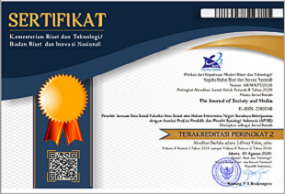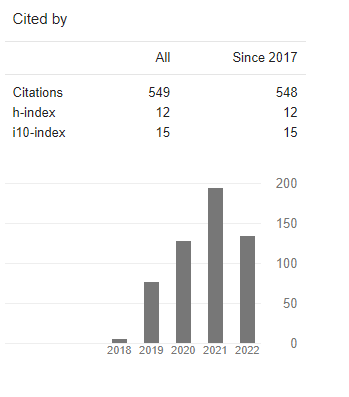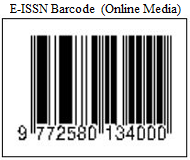Viral Content and Social Change in Rural Communities
DOI:
https://doi.org/10.26740/jsm.v9n2.p551-577Keywords:
Viral content, social values, rural communities, social media influence, ethicsAbstract
The rise of viral content on social media has transformed social behaviour and value systems, particularly in rural Indonesian communities exposed to unfiltered digital information. This study examines how viral content shapes traditional values and intergenerational relations. Using a qualitative case study approach, data were gathered through interviews, observations, and document analysis involving content creators, housewives, civil servants, and rural youth. The analysis included data reduction, classification, and interpretation. Findings reveal that viral content exerts both positive and negative effects. While some content promotes education and creativity, much of it normalises unethical behaviour and fosters individualism. Content creators often prioritize popularity over ethics, parents and teachers struggle to monitor youth exposure, and younger generations increasingly perceive traditional values as obsolete. This shift weakens communal norms such as cooperation, respect, and collective responsibility. The study concludes that viral content accelerates cultural transformation and erodes moral education in rural settings. Therefore, strengthening media literacy, digital ethics, and cultural revitalisation programs is crucial to balancing modernisation with the preservation of local wisdom and social cohesion in the digital era.
References
Adam, et al. 2016. “A Collaborative Health Promotion Approach to Improve Rural Health Delivery and Health Outcomes in Ghana: A Case Example of a Community-Based Health Planning and Services (CHPS) Strategy.” doi:10.5772/intechopen.97882.
Alamäki, A., T. Rantala, K. Valkokari, and K. Palomäki. 2018. “Business Roles in Creating Value from Data in Collaborative Networks.” IFIP Advances in Information and Communication Technology, 612–622. https://doi.org/10.1007/978-3-319-99127-6_53.
Alhaboby, Z. A., H. Al‐Khateeb, J. Barnes, H. Jahankhani, M. Pitchford, L. Conradie, and E. Short. 2021. “Cyber-Disability Hate Cases in the UK: The Documentation by the Police and Potential Barriers to Reporting.” Advanced Sciences and Technologies for Security Applications, 123–133. https://doi.org/10.1007/978-3-030-68534-8_8.
Antono, H. T., and M. Lutfi. 2022. “Dampak Sosial–Ekonomi Kegiatan UCG: Pertambangan Gasifikasi Batubara Bawah Tanah, Teknologi Non Konvensional Batubara.” https://doi.org/10.55981/brin.447.c343.
D o r a : V i r a l C o n t e n t a n d S o c i a l C h a n g e i n R u r a l C o m m u n i t i e s | 573
Antonovsky, A., G. P. Olswang, and L. Vaandrager. 2022. “Qualitative Approaches to the Study of the Sense of Coherence.” The Handbook of Salutogenesis, 581–609. https://doi.org/10.1007/978-3-030-79515-3_54.
Aswani, et al. 2017. “Exploring Content Virality in Facebook: A Semantic-Based Approach.” doi:10.1007/978-3-319-68557-1_19.
Binggeser, et al. 2014. “The Impact of Emotions on the Effectiveness of Viral Marketing Campaigns.” doi:10.1007/978-3-319-10873-5_219.
Čábyová, and Krajčovič. 2024. “Perspective Chapter: The TikTok Phenomenon – Harnessing Opportunities, Assessing Risks and Marketing Insights.” doi:10.5772/intechopen.1006038.
Carter, S. 2020. “Case Study Method and Research Design.” Advances in Early Childhood and K-12 Education, 301–326. https://doi.org/10.4018/978-1- 7998-2901-0.ch015.
Docherty, K. 2021. “Exploring Collective Leadership and Co-Production.” Advances in Public Policy and Administration, 130–155. https://doi.org/10.4018/978-1- 7998-4975-9.ch008.
Duman. 2021. “Rising Power of Today’s Brands.” doi:10.4018/978-1-7998-4420- 4.ch004.
Erwin, et al. 2023. “Social Media Micro-Enterprise: Utilizing Social Media Influencers, Marketing Contents, and Viral Marketing Campaigns to Increase Customer Engagement.” doi:10.2991/978-2-38476-064-0_58.
Falah, M. H., and F. W. Aptasari. 2023. “Tantangan Koperasi Nelayan sebagai Penyeimbang Rezim Pengelolaan Sumber Daya Kelautan dan Perikanan di Indonesia.” Pengelolaan Sumber Daya Perikanan Laut Berkelanjutan. https://doi.org/10.55981/brin.908.c765.
Fiftinova, F., E. Erlina, and M. Hambali. 2023. “Twine as a Digital Tool in Writing Digital Fiction: A Creative Writing Instruction in Higher Education.” Advances in Social Science, Education and Humanities Research, 208–225. https://doi.org/10.2991/978-2-38476-054-1_18.
574 | T h e J o u r n a l o f S o c i e t y a n d M e d i a 9 ( 2 )
Hoang, et al. 2011. “On Modeling Virality of Twitter Content.” doi:10.1007/978-3- 642-24826-9_27.
Humaedi, M. A., and F. N. Hakim. 2023. “Mencatat Wajo dalam Regsosek, Menghadirkan Wajah Indonesia.” Mencatat untuk Membangun Negeri: Narasi Emik Registrasi Sosial Ekonomi Jilid 1 Indonesia Tengah–Timur. https://doi.org/10.55981/brin.775.c697.
Husak, and Фіялка. 2018. “Social Media Influence on Public Opinion and Youth Behavior.” doi:10.30525/978-9934-571-27-5_17.
Iannone. 2018. “Viral Art Matters.” doi:10.4018/978-1-5225-5094-5.ch016.
Jamari, H. 2023. “A Decline in Earnings at the Empty Depot: Case Study at JP Logistics Sdn Bhd.” Advances in Social Science, Education and Humanities Research, 411–416. https://doi.org/10.2991/978-2-38476-046-6_42.
Johannesson, K. B. 2019. “Eye Movement Desensitization and Reprocessing (EMDR).” Innovations in CBT for Childhood Anxiety, OCD, and PTSD, 590– 609. https://doi.org/10.1017/9781108235655.029.
Juhaevah, F. 2023. “Ethnomathematics: The Early Determining Model of Ramadan and Eid al-Fitr in Hila Maluku.” Atlantis Highlights in Social Sciences, Education and Humanities, 23–32. https://doi.org/10.2991/978-94-6463-220- 0_4.
Kumanda, N., S. M. Chiphambo, and N. Mtsi. 2024. “Second-Year Students’ Perceptions of Transformative Learning Experiences: A Case Study in One of the South African Universities.” Metacognition in Learning – New Perspectives. https://doi.org/10.5772/intechopen.114229.
Kurniawan, S., and M. L. Maknun. 2023. “Moderasi Beragama di Indonesia: Peluang dan Tantangannya.” Moderasi Beragama: Akar Teologi, Nalar Kebudayaan, dan Kontestasi di Ruang Digital. https://doi.org/10.55981/brin.904.c737.
Lestari, E. 2023. “Cultivating Courage in Civics Learning in Elementary Schools.”
653–660. https://doi.org/10.2991/978-2-38476-086-2_56.
Lichtner, V., A. Irnazarow, O. Johnson, S. Bush, S. Macmillan, and M. Songhurst.
2024. “Systems for Identification and Location of Items at Scale: Study of
D o r a : V i r a l C o n t e n t a n d S o c i a l C h a n g e i n R u r a l C o m m u n i t i e s | 575
Scan4Safety in Leeds Hospitals.” Studies in Health Technology and Informatics. https://doi.org/10.3233/shti240222.
Mantilla. 2015. “Gendertrolling.” doi:10.5040/9798400656026.
Markantoni, et al. 2023. “Can Community Interventions Change Resilience? Fostering Perceptions of Individual and Community Resilience in Rural Places.” doi:10.4324/9781003240297-11.
Michael, and Ramtekkar. 2022. “Overcoming Barriers to Effective Suicide Prevention in Rural Communities.” doi:10.1007/978-3-031-06127-1_17.
Mudra, I. W., I. N. L. Julianto, I. P. K. Muka, and I. W. Swandi. 2023. “Sangku as Indonesian Cultural Property.” Advances in Social Science, Education and Humanities Research, 1268–1274. https://doi.org/10.2991/978-2-38476-118- 0_144.
Musfeptial, M., D. Nasri, M. Mulyadi, P. Pramono, I. Adilla, and H. Hermansyah. 2023. “Kristalisasi Moderasi Beragama di Kalangan Ulama Minangkabau Melalui Syair.” Moderasi Beragama: Akar Teologi, Nalar Kebudayaan, dan Kontestasi di Ruang Digital. https://doi.org/10.55981/brin.904.c743.
Nagata, D. K., L. A. Suzuki, and L. P. Kohn-Wood. 2012. “Qualitative Research with Ethnocultural Populations: Addressing the Unique Challenges of Relationship, Role, and Context.” Qualitative Strategies for Ethnocultural Research, 9–18. https://doi.org/10.1037/13742-001.
Prichard, C., D. Jones, and R. Stablein. 2004. “Doing Research in Organizational Discourse: The Importance of Researcher Context.” The SAGE Handbook of Organizational Discourse, 213–236. https://doi.org/10.4135/9781848608122.n10.
Qian. 2017. “Public vs. Private Ownership of Firms: Evidence from Rural China.”
doi:10.7551/mitpress/9780262534246.003.0007.
Sabdey, A., S. Suryadi, S. Zauhar, and E. Setyowati. 2023. “The Role of Actors in the
Implementation of Spatial Planning Policy in Lamandau Regency in the
576 | T h e J o u r n a l o f S o c i e t y a n d M e d i a 9 ( 2 )
Slogan Nanga Bulik Kota Indah.” Advances in Social Science, Education and Humanities Research, 51–59. https://doi.org/10.2991/978-2-38476-082-4_6.
Santie, Y., R. Fordatkosu, A. R. Umaternate, and R. Mesra. 2023. “The Role of the Village Consultancy Board in Infrastructure Development in Fursuy Village, Selaru District, Maluku Tenggara Barat Regency.” Advances in Social Science, Education and Humanities Research, 1708–1713. https://doi.org/10.2991/978-2-494069-35-0_202.
Sapawuryandari, N. 2023. “Menjaga Lingkungan Alam melalui Karya Sastra: Cerita Rakyat Yogyakarta.” Sastra dan Ekologi. https://doi.org/10.55981/brin.304.c594.
Suzuki, L. A., and C. A. Quizon. 2012. “Interdisciplinarity in Qualitative Research with Ethnocultural Populations.” Qualitative Strategies for Ethnocultural Research, 21–40. https://doi.org/10.1037/13742-002.
Trotta, A., R. Carè, R. Caridà, and M. C. Migliazza. 2021. “Fighting Poverty and Inequalities Through Social Impact Bonds: Learning from Case Studies to Support the COVID-19 Response.” Palgrave Studies in Impact Finance, 37–
89. https://doi.org/10.1007/978-3-030-65133-6_3.
Tsephe, L. 2023. “Supervision Is One of the Critical Aspects of Doctoral Education.” Factors Impacting African Women’s Doctoral Success, 37–47. https://doi.org/10.4102/aosis.2023.bk411.03.
Wati, A. P., J. A. Martha, N. A. Fransiska, and D. Andarista. 2022. “Integration of Web Media and Pedagogical Content Knowledge in Learning During the Pandemic.” Advances in Social Science, Education and Humanities Research, 310–322. https://doi.org/10.2991/978-2-494069-63-3_28.
Willis, M., and M. H. Jarrahi. 2019. “Automating Documentation: A Critical Perspective into the Role of Artificial Intelligence in Clinical Documentation.” Lecture Notes in Computer Science, 200–209. https://doi.org/10.1007/978-3-030-15742-5_19.
D o r a : V i r a l C o n t e n t a n d S o c i a l C h a n g e i n R u r a l C o m m u n i t i e s | 577
Zhang, P., D. Song, X. Zhao, and Y. Hou. 2010. “A Study of Document Weight Smoothness in Pseudo Relevance Feedback.” Lecture Notes in Computer Science, 527–538. https://doi.org/10.1007/978-3-642-17187-1_50.
Downloads
Published
How to Cite
Issue
Section
License
Copyright (c) 2025 The Journal of Society and Media

This work is licensed under a Creative Commons Attribution 4.0 International License.
 Abstract views: 143
,
Abstract views: 143
, PDF Downloads: 94
PDF Downloads: 94












